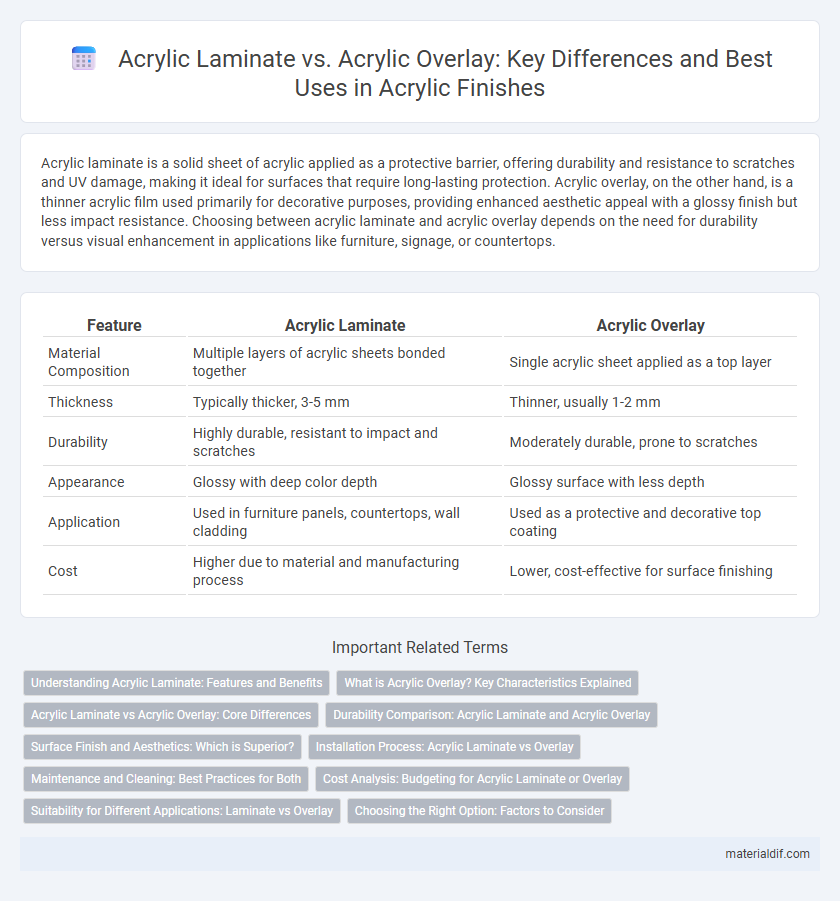Acrylic laminate is a solid sheet of acrylic applied as a protective barrier, offering durability and resistance to scratches and UV damage, making it ideal for surfaces that require long-lasting protection. Acrylic overlay, on the other hand, is a thinner acrylic film used primarily for decorative purposes, providing enhanced aesthetic appeal with a glossy finish but less impact resistance. Choosing between acrylic laminate and acrylic overlay depends on the need for durability versus visual enhancement in applications like furniture, signage, or countertops.
Table of Comparison
| Feature | Acrylic Laminate | Acrylic Overlay |
|---|---|---|
| Material Composition | Multiple layers of acrylic sheets bonded together | Single acrylic sheet applied as a top layer |
| Thickness | Typically thicker, 3-5 mm | Thinner, usually 1-2 mm |
| Durability | Highly durable, resistant to impact and scratches | Moderately durable, prone to scratches |
| Appearance | Glossy with deep color depth | Glossy surface with less depth |
| Application | Used in furniture panels, countertops, wall cladding | Used as a protective and decorative top coating |
| Cost | Higher due to material and manufacturing process | Lower, cost-effective for surface finishing |
Understanding Acrylic Laminate: Features and Benefits
Acrylic laminate is a durable surface material composed of multiple resin-impregnated layers fused under heat and pressure, offering high resistance to scratches, stains, and impact. Its non-porous nature ensures easy cleaning and maintenance, making it ideal for kitchen countertops, cabinetry, and furniture. The glossy finish enhances aesthetic appeal while maintaining long-term durability and color retention.
What is Acrylic Overlay? Key Characteristics Explained
Acrylic overlay is a thin layer of transparent or colored acrylic material applied over surfaces to enhance durability and aesthetic appeal. Key characteristics include excellent scratch resistance, UV protection, and a glossy finish that mimics glass while being lightweight and shatterproof. Common applications involve furniture, countertops, and automotive parts, where added protection and visual enhancement are essential.
Acrylic Laminate vs Acrylic Overlay: Core Differences
Acrylic laminate is a pre-finished sheet of acrylic material that is fused onto surfaces to provide durability and a smooth, glossy finish, whereas acrylic overlay involves applying a thin layer of acrylic over an existing substrate for enhancement or repair. Acrylic laminate offers higher resistance to scratches and impact due to its solid construction, while acrylic overlay primarily serves as a surface treatment that can be replaced or refreshed. Core differences include application methods, durability, thickness, and maintenance, with acrylic laminate being more robust and acrylic overlay offering easier customization and repair options.
Durability Comparison: Acrylic Laminate and Acrylic Overlay
Acrylic laminate offers superior durability with a harder surface resistant to scratches, heat, and impact compared to acrylic overlay, which tends to be thinner and more prone to damage. The thicker composition of acrylic laminate enhances its resistance to wear and chipping, making it ideal for high-traffic areas. In contrast, acrylic overlay provides aesthetic appeal but requires more maintenance due to its lower resistance to abrasions and environmental factors.
Surface Finish and Aesthetics: Which is Superior?
Acrylic laminate offers a durable surface finish with a high-gloss sheen that resists scratches and maintains vibrant color over time, making it ideal for applications requiring long-lasting aesthetics. In contrast, acrylic overlay provides a thinner, more flexible finish that enhances surface smoothness but may be more susceptible to wear and discoloration. For superior surface finish and sustained aesthetic appeal, acrylic laminate generally outperforms acrylic overlay in both durability and visual impact.
Installation Process: Acrylic Laminate vs Overlay
Acrylic laminate installation involves precisely adhering thin acrylic sheets onto surfaces using strong adhesives and heat to ensure a durable, smooth finish, often requiring professional tools for seamless application. Acrylic overlay installation typically entails applying a thicker acrylic layer, which can accommodate minor surface imperfections, and may involve additional steps such as surface preparation and curing for optimal adhesion and longevity. Both methods demand careful alignment and finishing to achieve high-quality, glossy surfaces, but overlays generally require more intensive surface treatment compared to laminates.
Maintenance and Cleaning: Best Practices for Both
Acrylic laminate requires gentle cleaning with non-abrasive, pH-neutral detergents to preserve its glossy finish and prevent scratches. Acrylic overlay demands similar maintenance, emphasizing the use of soft microfiber cloths and avoiding harsh chemicals that can cause cloudiness or damage. Regular dusting and immediate spill cleanup ensure durability and maintain the high-quality appearance of both acrylic surfaces.
Cost Analysis: Budgeting for Acrylic Laminate or Overlay
Acrylic laminate generally offers a lower initial cost compared to acrylic overlay, making it a budget-friendly option for large-scale projects. Acrylic overlay, while more expensive upfront, provides enhanced durability and a higher-end finish that may reduce long-term maintenance costs. Careful cost analysis should consider both installation expenses and the lifespan of each material to determine the best value for budget-conscious applications.
Suitability for Different Applications: Laminate vs Overlay
Acrylic laminate offers superior durability and glare resistance, making it ideal for high-traffic surfaces like countertops and furniture where wear and tear are common. Acrylic overlays provide a thinner, more flexible option suited for decorative finishes and light protective layers on walls or cabinetry, enhancing aesthetic appeal without significant structural reinforcement. Choosing between laminate and overlay depends on the required durability, thickness, and specific application area, ensuring optimal performance and longevity.
Choosing the Right Option: Factors to Consider
When choosing between acrylic laminate and acrylic overlay, consider durability, application process, and cost-effectiveness. Acrylic laminate offers a pre-finished surface with superior scratch resistance suitable for high-traffic areas, while acrylic overlay provides a customizable finish ideal for refinishing existing surfaces. Evaluating factors like project scope, desired aesthetics, and long-term maintenance helps determine the most appropriate acrylic solution.
Acrylic Laminate vs Acrylic Overlay Infographic

 materialdif.com
materialdif.com